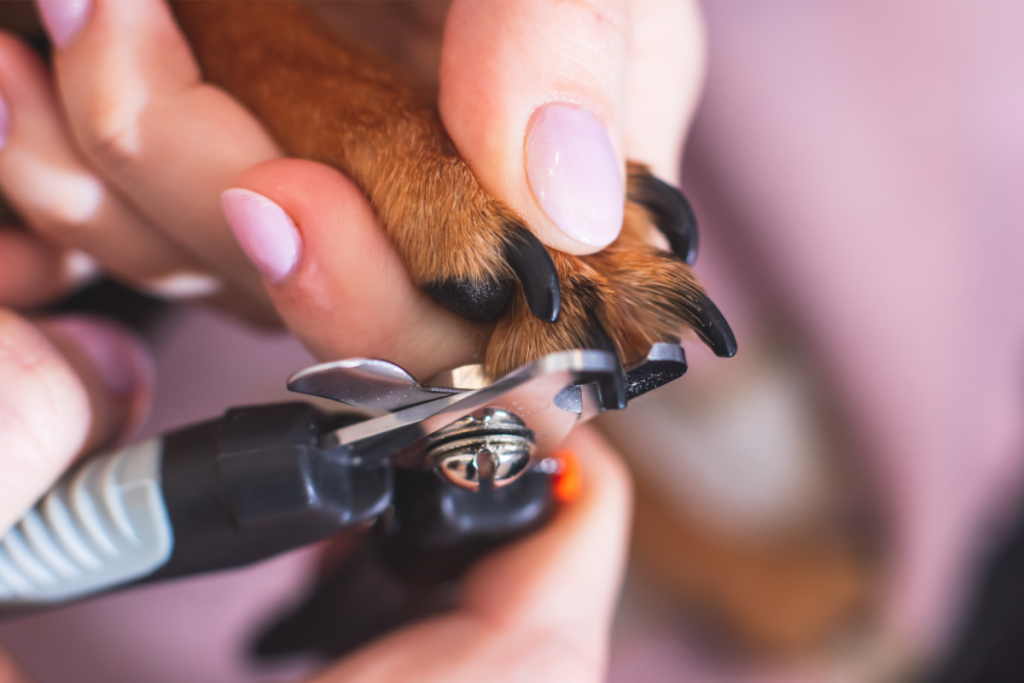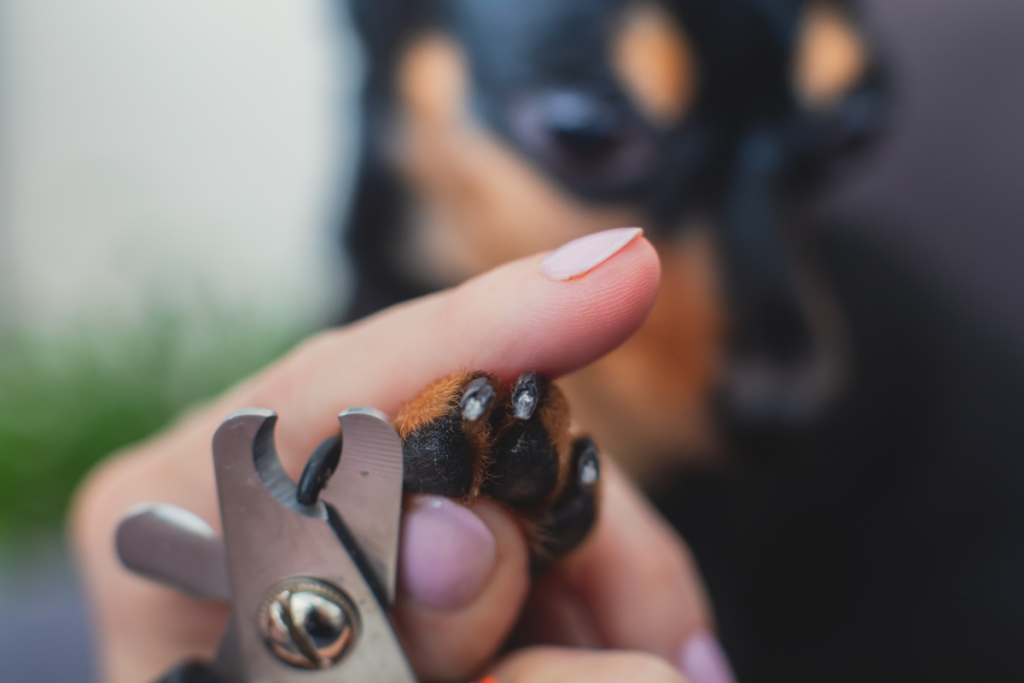Trouble clipping your Irish Setter’s nails? You are not alone. Many pet owners struggle to clip Irish setter nails, especially with bigger canines. But don’t worry; you can trim your dog’s nails safely and effectively with the appropriate equipment and technique. This article explains how to cut Irish Setter nails. For healthy and pleasant dog paws, you’ll learn optimal placement to avoiding the quick. Grab your clippers, and let’s begin this vital grooming duty!
Understanding Your Irish Setter’s Nail Anatomy

Before we delve into how to cut Irish setter nails, let’s start by understanding the general anatomy of Irish setter nails. A dog’s nail comprises two primary parts: the hard outer shell called the ‘keratin’, and the living tissue known as the ‘quick .’The keratin is the part that needs to be trimmed regularly, while the quick houses the sensitive blood vessels and nerves.
The quick is a vital component that you must be cautious about when trimming your Irish Setter’s nails. If you accidentally cut into the quick, it can cause pain and bleeding. Identifying where the quick ends is crucial before proceeding with the nail trim. Generally, the quick appears as a pinkish area within the nail, closer to the base. However, keep in mind that the length of the quick can vary from dog to dog.
Understanding the anatomy of your Irish Setter’s nails, especially the location of the quick, is essential for safe and effective nail trimming. By being aware of the sensitive nature of the quick, you can prevent any unnecessary pain or discomfort for your beloved pet.
Why is Regular Nail Trimming Essential for Your Irish Setter?
As a responsible dog owner, prioritizing your furry friend’s health and well-being is crucial. Regular nail trimming is an essential aspect of grooming that often gets overlooked but is incredibly important for your Irish Setter’s overall health. In this article, we’ll explore why keeping your Irish Setter’s nails trimmed is essential and how neglecting this aspect can have negative implications.
✔️The Health Implications of Overgrown Nails:
Overgrown nails in Irish Setters can lead to a variety of health issues. Nails can curl and grow into your dog’s paw pads when they become too long. It can cause discomfort, pain, and even infections. Additionally, overgrown nails may alter your Irish Setter’s gait, which can strain their joints unnecessarily and potentially lead to musculoskeletal problems. By regularly trimming your Irish Setter’s nails, you can prevent these health complications from arising.
✔️Discomfort and Potential Pain Caused by Overgrown Nails:
Imagine constantly walking with nails that are way too long – it’s uncomfortable, to say the least. The same goes for your Irish Setter. Overgrown nails can cause discomfort when walking or running, as they may press against the ground and put pressure on the nail bed. This pressure can lead to soreness, inflammation, and even pain. Additionally, long nails can get caught in carpet fibers, fabrics, or other surfaces, causing your Irish Setter further discomfort or potential injuries. Maintaining regular nail trims can help ensure your Irish Setter’s comfort and prevent unnecessary pain.
Regular nail trimming is not just a cosmetic procedure for your Irish Setter; it is essential for their overall health and well-being.
Tools You Need to Cut Irish Setter Nails

In order to ensure a successful and stress-free nail trimming session for your Irish Setter, it’s important to have the right tools at hand. Having the proper equipment makes the process easier and helps maintain safety and precision.
✂️Nail Clippers
Nail clippers are the primary tool to effectively trim your Irish Setter’s nails. Look for clippers specifically designed for dogs, as they have features that make the task easier and safer. Opt for clippers with sharp stainless steel blades and ergonomic handles for better control and comfort.
✂️Nail Grinder
For pet owners who prefer a more gradual approach to nail trimming or have dogs with particularly hard nails, a nail grinder can be a great addition to your grooming toolkit. Nail grinders use a rotating sanding drum to gradually file down the nail. Look for a grinder with adjustable speed settings and a quiet motor to minimize noise and vibration that might startle your Irish Setter.
✂️Styptic Powder or Gel
Accidents happen, and if you accidentally cut your Irish Setter’s nail too short and cause bleeding, having styptic powder or gel on hand is essential. These products help stop bleeding quickly by promoting clotting. Follow the instructions provided with the product and apply it gently to the affected area using a cotton swab or your fingertip.
You’ll be well-equipped to maintain your Irish Setter’s nails and keep them in optimal health by using the proper tools.
Step-By-Step Guide on How to Trim Your Irish Setter Nails
Now that you have the necessary tools, here is a step-by-step guide on how to trim your Irish Setter’s nails safely and effectively. This guide may also apply to other breeds, but always consult a professional groomer or veterinarian if you have any concerns.
1: Prepare the Environment
Before trimming your Irish Setter’s nails, creating a calm and comfortable environment is essential. Find a quiet space where both you and your furry friend can relax. Ensure you have good lighting to see the nails clearly and avoid any potential accidents.
2: Introduce the Tools
Gently introduce your Irish Setter to nail-trimming tools, such as a quality pair of dog nail clippers and styptic powder. Let them sniff and get familiar with the tools to reduce any anxiety they may have.
3: Familiarize Your Dog with Handling
To make the nail trimming process easier, it’s essential to familiarize your Irish Setter with handling their paws. Begin by gently touching and massaging their paws, rewarding them with treats and praise for their calm behavior. Gradually increase the duration of handling sessions over time.
4: Start with Short Sessions
In the beginning, start with short nail trimming sessions to help your Irish Setter get accustomed to the process. Trim just a small portion of the nail to avoid cutting into the quick, sensitive part of the nail that contains blood vessels.
5: Identify the Quick
Take a close look at your Irish Setter’s nails to identify the quick, which may appear as a pinkish area inside the nail. It’s crucial not to cut into the quick, as it can cause bleeding and discomfort. The quick may be easier to spot if your dog has clear or light-colored nails.
6: Make Steady Cuts
Hold your Irish Setter’s paw firmly but gently. Carefully position the clippers perpendicular to the nail and make steady cuts, taking off small portions at a time. Remember to trim only the pointed tip of the nail and avoid cutting too close to the quick.
7: Prepared for Accidents
Even with utmost care, accidents can happen, and you may accidentally cut into the quick, causing bleeding. If this occurs, stay calm and apply styptic powder or gel to the affected area to stop the bleeding. Gently press the powder or gel against the nail and hold it in place for a few seconds. If the bleeding persists or if you’re unsure, consult your veterinarian.
8: Monitor Progress
Regularly check your Irish Setter’s nails and monitor their growth. Depending on the rate of nail growth, you may need to trim them every 2-4 weeks. Maintaining a consistent trimming schedule can prevent nails from becoming overly long and uncomfortable for your furry friend.
9: Reward and Reassure
Remember to reward your Irish Setter with treats and praise throughout the nail-trimming process. Positive reinforcement will help create a positive association with nail trimming, making future sessions easier.
By following this step-by-step guide, you can confidently trim your Irish Setter’s nails in a safe and effective manner.
How to Handle Trimming Difficulties

Dealing with trimming difficulties can be a challenging task. Still, with the right approach, you can overcome these obstacles and ensure a positive experience for you and your Irish Setter. Cutting your dog’s nail too short can be painful and may cause bleeding. If this happens, staying calm and taking immediate action is important. Here’s what you can do:
- Apply Styptic Powder: Styptic powder helps stop bleeding quickly by promoting clotting. Dip the bleeding end of the nail into the powder or apply it using a cotton swab. Apply gentle pressure to help the powder adhere to the bleeding area.
- Use Cornstarch or Flour: If you don’t have styptic powder on hand, you can use cornstarch or flour as an alternative. Apply a small amount to the bleeding nail and gently press down to promote clotting.
- Apply Pressure: Using a clean cloth or gauze pad, apply gentle pressure to the bleeding nail for a few minutes. It can help stop the bleeding and allow the clotting process to begin.
- Monitor the Nail: Keep an eye on the nail to ensure that bleeding has stopped. If bleeding persists or your dog appears in pain, contact your veterinarian for further guidance.
→Dealing with a Nervous Dog
Some dogs may become anxious or fearful during the nail-trimming process. To help alleviate their stress and make the experience more comfortable, try the following techniques:
- Gradual Desensitization: Introduce your Irish Setter to the nail-trimming process slowly and gradually. Start by simply touching their paws and rewarding them with treats and praise. Over time, work your way up to handling their paws for longer periods and eventually introducing the clippers.
- Positive Reinforcement: Use positive reinforcement techniques to create a positive association with nail trimming. Reward your dog with treats, praise, and encouragement throughout the process. This will help them feel more relaxed and cooperative.
- Take Breaks: If your dog becomes too anxious or stressed, take breaks during the nail trimming session. Allow them time to calm down and resume when they’re more relaxed. It’s important to take your time with the process and prioritize your dog’s comfort.
- Seek Professional Help: If you still have difficulty handling your dog’s anxiety during nail trimming, consider seeking assistance from a professional dog trainer or veterinarian. They can provide additional guidance and support tailored to your dog’s specific needs.
Remember, patience and understanding are key when dealing with trimming difficulties. With time and practice, you and your Irish Setter can establish a comfortable nail trimming routine that keeps their nails healthy and prevents further complications.
When to Seek Professional Help
While grooming your dog can be a rewarding experience, there are certain situations where seeking help from a professional groomer or veterinarian is the best course of action. These professionals have the expertise and experience to handle complex grooming needs and ensure the safety and well-being of your furry friend.
✍️Difficult or Aggressive Behavior
If your dog displays difficult or aggressive behavior during grooming sessions, it’s essential to prioritize their safety and the safety of those involved. Professional groomers are trained to handle challenging dogs and have techniques to keep them calm and cooperative during grooming. They have the necessary skills and equipment to safely manage difficult behavior, minimizing stress for the dog and the groomer.
✍️Specialized Grooming Needs
Certain dog breeds or specific grooming requirements may necessitate the expertise of a professional groomer. For example, dogs with intricate coat patterns, often require skilled clipping and styling techniques. Professional groomers have the knowledge and tools to achieve the desired look while maintaining the integrity of the dog’s coat.
Similarly, if your dog has specific medical conditions affecting their skin, coat, or nails, a vet may be better equipped to address those needs during grooming.
✍️Nail Trimming Challenges
Many pet owners find nail trimming to be a daunting task, especially if their dog becomes anxious or resistant. If you struggle with trimming your dog’s nails or have concerns about cutting the quickly, a professional groomer or vet can provide the necessary expertise. They can trim the nails safely and accurately, reducing your dog’s risk of injury or discomfort.
✍️Specialized Grooming Services
Professional groomers offer specialized grooming services that may not be available or feasible for pet owners to perform at home. These services often include specialized baths, coat treatments, teeth cleaning, and ear care. If you want to ensure your dog receives thorough and professional grooming, taking them to a groomer can be the best option.
These professionals have the knowledge, skills, and tools necessary to provide the highest level of care, ensuring that your furry friend remains healthy, happy, and well-groomed.
Frequently Asked Questions
How often should I trim my Irish Setter’s nails?
The frequency of nail trims will depend on your dog’s activity level and how quickly their nails grow. Generally, it’s recommended to trim your Irish Setter’s nails every 2-4 weeks. Regular trims help prevent nails from becoming too long, which can be uncomfortable for your furry friend.
Can I trim my Irish Setter’s nails with regular human nail clippers?
It’s best to use nail clippers specifically designed for dogs. Human nail clippers may need to be stronger to effectively trim your Irish Setter’s nails. Dog nail clippers have different shapes and provide better control, making the process safer and easier for you and your dog.
Should I trim my Irish Setter’s nails before or after a bath?
Trimming your Irish Setter’s nails before a bath is generally recommended. When the nails are dry, it’s easier to see the quick and make precise cuts without any slipperiness. Additionally, some dogs find nail trimming stressful, so it’s better to do it before bathing when they are calmer.
Should I be concerned if my Irish Setter’s nails are clicking on the floor when they walk?
If you hear clicking sounds when your Irish Setter walks, it’s a sign that their nails are too long. Long nails can cause discomfort, difficulty walking, and even joint issues. Trimming their nails to a proper length is essential to prevent these problems and ensure their overall well-being.
What should I do if my Irish Setter’s nails are black and I can’t see the quick?
Black nails can make it challenging to see the quick, sensitive part of the nail. To be safe, it’s recommended to trim only the pointed tip of the nail. Take small cuts at a time and gradually work towards the desired length. If unsure, consult a professional groomer or veterinarian for guidance.
How can I train my Irish Setter to tolerate nail trimming?
Training your Irish Setter to tolerate nail trimming involves patience and positive reinforcement. Start by gradually introducing them to the process, touching their paws, and rewarding them with treats and praise. Gradually increase the duration of handling sessions over time. To create a more relaxed environment, associate nail trimming with positive experiences.
Final Words
Learning how to cut your Irish Setter nails can be a daunting task for anyone, but it is a task that shouldn’t be ignored. As a proud dog owner, I can tell you that the sound of my dog’s nails clicking on the floor can be extremely annoying and even painful. Sure, taking your dog to the groomer or the vet to get their nails clipped is an option, but doing it yourself can save you time and money.
Just ensure you have the proper tools, like a nail clipper designed for dogs, and take the time to familiarize yourself with your dog’s anatomy and how to hold their paws. It may take a bit of practice, but soon enough, you’ll be able to clip your Irish Setter’s nails with confidence, and your dog will thank you for it. Remember, keeping your dog’s nails short and tidy is important to their overall health and well-being.

